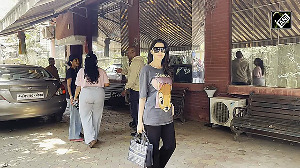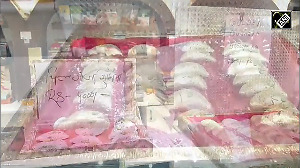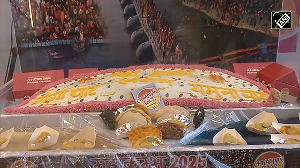Manish Jain and his wife Seema waited outside the operating theatre of Escorts Heart Institute and Research Centre in Delhi while their 14-month-old baby, Mansee, underwent her second major open heart surgery.
At the end of five hours, which seemed like an eternity, the doctors emerged to say they weren't sure whether the child would stay alive or not. Mansee was moved to the post-operative room and hooked to several life support machines. It was only three days after the surgery that Mansee began moving and showing signs of having survived the surgery, and some of the complicated machinery that kept her alive could be taken off.
It took a few more days for her to open her eyes and even then Manish and Seema could not be sure whether she was completely okay.
After spending 25 days in the hospital in January 2005, most of it in the intensive care unit, Mansee finally came home with a newly grafted heart. That, however, was not the end of her medical complications.
- MUST READ: Don't let high medical bills kill you
The following month, Mansee had a third surgery, in which a pacemaker was placed in her heart. The expected life of a pacemaker is difficult to assess, especially in the case of a small child, but even so, the Jains thought it would last at least a few years.
However, Mansee developed certain complications and the pacing pattern had to be changed, which ended up draining the battery of the pacemaker. A year and a few months after it was first placed, little Mansee was wheeled into an operating theatre again, this time to have the old pacemaker replaced with a new one.
Manish says that he would not like to think that their lives have been adversely affected due to Mansee's health problem.
Keeping the beat steady
When Seema was pregnant with Mansee, she underwent all the necessary tests and scans that are routinely carried out. There were no anomalies. Four months after she was born, the Jains noticed a 'failure to thrive' in their child, she was not gaining weight. And, then, a nightmare started unfolding.
They discerned abnormal movements in their little baby's chest. It was then that Manish, a practising ophthalmologist, took his daughter to a pediatrician, who confirmed his worst fears after an ECG. Mansee had a congenital heart problem, medically known as atrio-ventricular septal defect. She had her first surgery in January 2005 when a prosthetic valve was built into her heart.
Now, after battling her way through four surgeries, Mansee is an active and playful three-and-a-half-year-old child and older sister to Maitreyi, the Jains' six-month-old daughter.
The costs of cure
This can either be a story of crushing heartbreak or one of incredible strength. Manish, Seema and Mansee are determined to make it a grand illustration of immense positivism. Mansee's medical troubles are not over; they have only temporarily abated. "Her pacemaker will certainly have to be replaced. At some point in the future, she would also need a second valve, which will require another major open heart surgery," says Manish.
If things go well, these surgeries could wait till Mansee's late teens, but this cannot be said with any conviction. Complications could arise tomorrow, or next week, or next year -- it's an uncertainty that the Jains have to live with.
Manish, who for the last seven years has been teaching at a medical college at Haldwani in Nainital district, and Seema, who was a research fellow at the Forest Research Institute, Dehradun, put in their entire savings to fund Mansee's early surgeries. They also took loans from banks and borrowed money from relatives to be able to afford Mansee's treatment.
The bank loan was paid off recently and the Jains have to ensure that they build a nest egg to fund her future surgeries. "The accepted rate of inflation for a surgery is around 6 per cent per year," says Manish. "I would peg it more realistically at around 9 per cent.
Her open heart surgery coupled with valve replacement would cost about Rs 5.75 lakh (Rs 575,000) at today's cost. A pacemaker costs Rs 35,000 and the replacement surgery would cost an additional Rs 1 lakh (Rs 100,000) today. This is the minimum that we should save. Plenty of other costs would be involved."
Making sense of it
Anybody who has seen or taken care of a close relative or friend who is unwell knows how painful it is to see one's loved one suffer. This anguish is magnified many times over when it's your child who is lying supine, invasive tubes running through her body, and all you can do is clutch helplessly at hope and bear your aching love.
Manish and Seema stand strong for each other. "Seema was far more courageous about this than I expected her to be. One factor that gave me strength was the fact that she was there with me," says Manish.
In a separate conversation, Seema says, "I got my strength from my husband. He is a doctor, he gave me books about Mansee's problem so that I could read and understand exactly what was happening, and he always rationalised everything for me."
The Jains are rationalists. They never asked the "why us" question. "We believe that these are random occurrences and it is purely by chance that it happened to our daughter. We don't curse anybody, we believe it could have happened to anyone," Manish says.
Seema concurs, "We believe in God, but we are not very religious. We talk of God, but we don't think that God will come and help us; we know we have to help ourselves. This child has come to us, we have to take care of her, we don't complain."
Most of all, Mansee's smile keeps Seema going. "After every crisis, Mansee has woken up and smiled at me," says Seema. "I keep thinking she is going to wake up now and give me that smile of hers, and that is all I need. My husband and I think that God or whoever created her knew that we would be the best people to look after her. She has come to us because of that. At some point in the future, we will have to sit her down and explain her condition to her. We are preparing ourselves for that."
Call of the future
Both Manish and Seema have plans for their future. Manish wants to take the FRCS exam sometime next year. Seema, who is also a textile designer, wants to start a business of her own. They would both be able to find more lucrative options if they move to a larger city. But, for now, they do not want to destabilise their surroundings and put their children through the stress of a new beginning. That would have to wait until Mansee's health steadies.
"I would like to think that our lives are not in anyway disadvantaged because of my daughter's health," says Manish. "Some short-term decisions have been made around her, but for the long term, our plans are as they would have been had she not been diagnosed with this problem."
Mansee also has plans for her future. A few months ago, she wanted to grow up to be a security guard, then it was a doctor and her latest choice of profession is teaching.
But all that is a long time away. For now, whether she is fighting for her the attention of her parents or is busy playing older sister, her special little heart is beating away, steadily and rhythmically, and that, really, is all that matters.
|
Financial plan by Gaurav Mashruwala, CFP | ||
|
The issues The financial goals of the Jain family-- Seema, Manish, and their kids Mansee, who is suffering from a heart ailment, and Maitreyi--in the order of priority are:
All the costs are at today's rate of inflation. |
Diagnosis Cash-Flow: Inflow from all sources is Rs 5.09 lakh. Outflow is Rs 3.73 lakh, including taxes, EPF contribution, insurance premium and other routine expenses. Monthly surplus is about Rs 19,000 after taxes. Statement of Net Worth: Total assets are worth Rs 5.19 lakh. The couple do not have any liability. Contingency Reserve: Rs 85,000 is in bank savings account and Rs 10,000 in cash at home to meet any contingency. Health & Life insurance: The family does not have health cover. Total life cover is Rs 6.25 lakh. Savings & Investment: Investment in equity: Rs 30,900; equity-based mutual funds: Rs 25,000; bond/FD: Rs 5,000, EPF/PPF: Rs 3.10 lakh; and others: Rs 23,000. Cost of jewellery: Rs 30,000. Equity: 14 per cent; debt: 86 per cent. Fiscal Analysis: The couple have a simple lifestyle. Monthly surplus is enough for meeting their future goals. Major healthcare costs are expected ahead. Contingency reserve fund is sufficient. Family needs health insurance. Life insurance is insufficient. As insurance is through investment-oriented policies, large amounts are going into insurance premium and generating sub-optimal returns. Equity exposure is less. Family does not have a house. |
Recommendations Contingency: Keep Rs 85,000 in bank savings account linked to fixed deposit and Rs 10,000 in cash at home. Insurance: Rs 5 lakh health cover for every family member. Find out when insurer will start paying for treatment of existing diseases; many would only after 5 years. Rs 40 lakh term plan with critical illness rider for Manish. Savings & Investment: For exam fee: sell shares and invest in debt-based MF; SIP of Rs 10,000 per month in debt fund. Pacemaker after 4 and 8 years: SIP of Rs 4,000 per month in MFs; ensure debt to equity ratio is 35:65. Pacemaker after 12 and 16 years: SIP of Rs 1,500 per month in equity-oriented MF. Intracardiac surgery and valve replacement: SIP of Rs 1,500 per month in equity-oriented MF. After accumulating exam fund, start an SIP of Rs 12,500 per month in equity MF for kids' education and marriage. Keep debt to equity ratio of new investment at 67:33 in current year, excluding EPF. From next year, invest 100 per cent in equity, excluding EPF. Use existing EPF, equity MF, bond and other investments for emergency health needs. Invest regularly for wife's business, house and retirement when income increases. Tax: Benefits u/s 80C; 80 DDB for Mansee's cure; 80D for mediclaim premium. The planner can be reached at gmashruwala@gmail.com |
- MUST READ: Don't let high medical bills kill you






 © 2025
© 2025